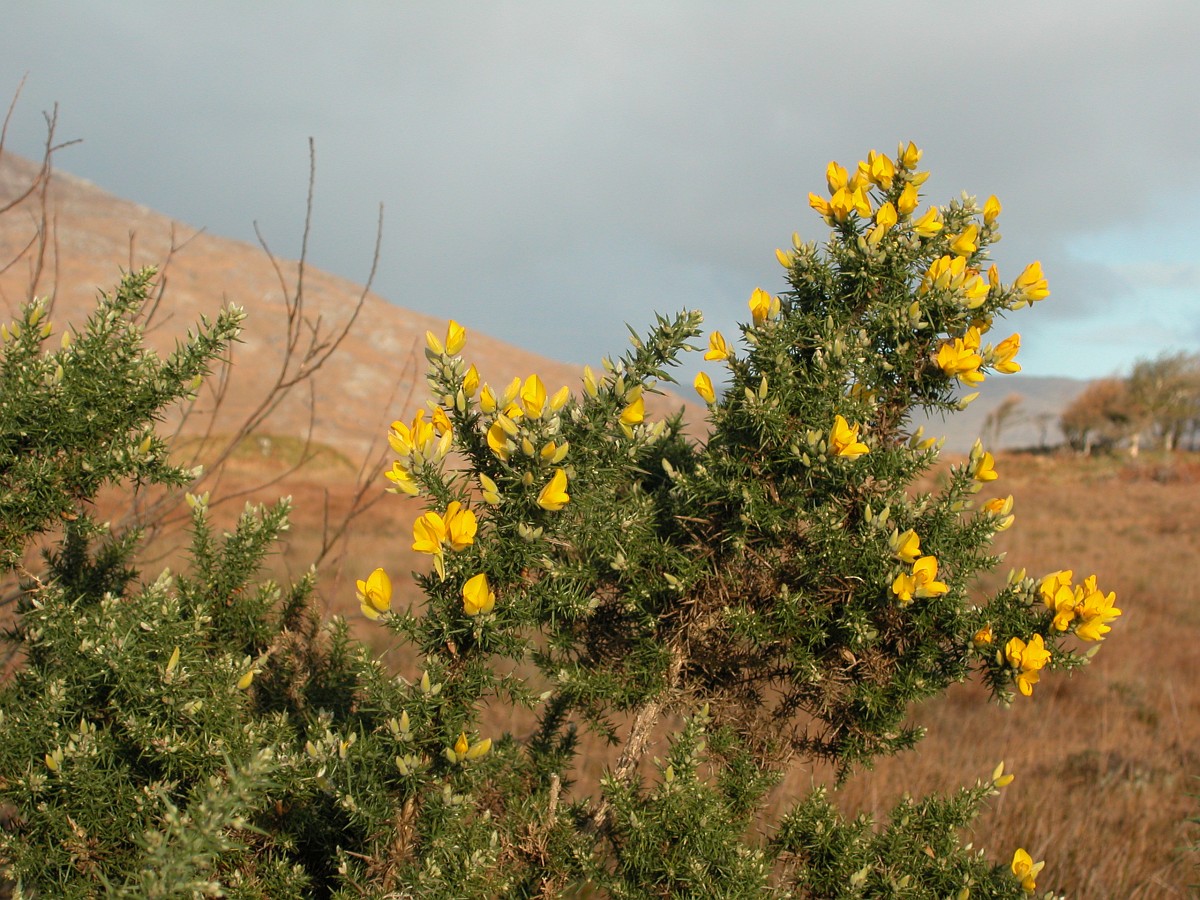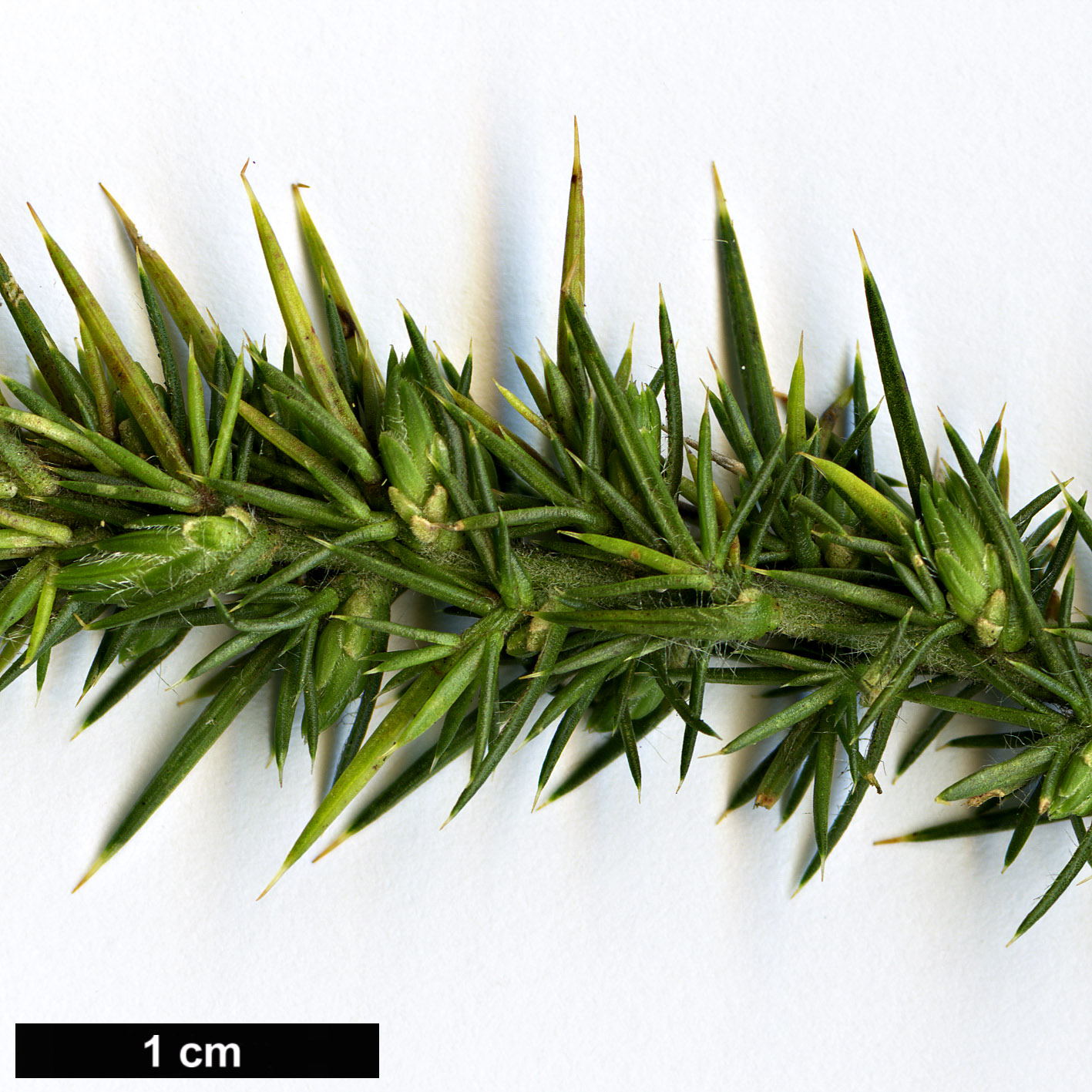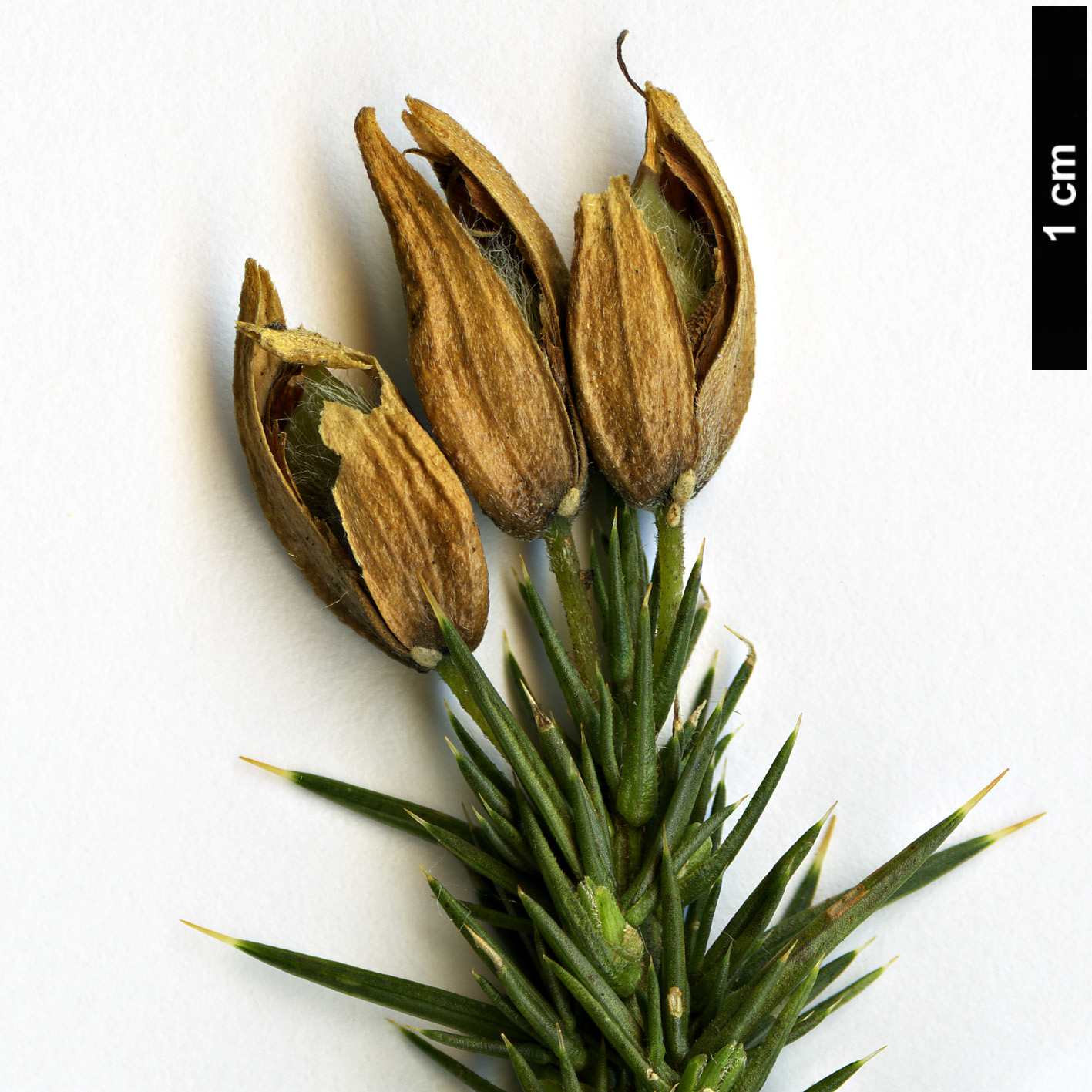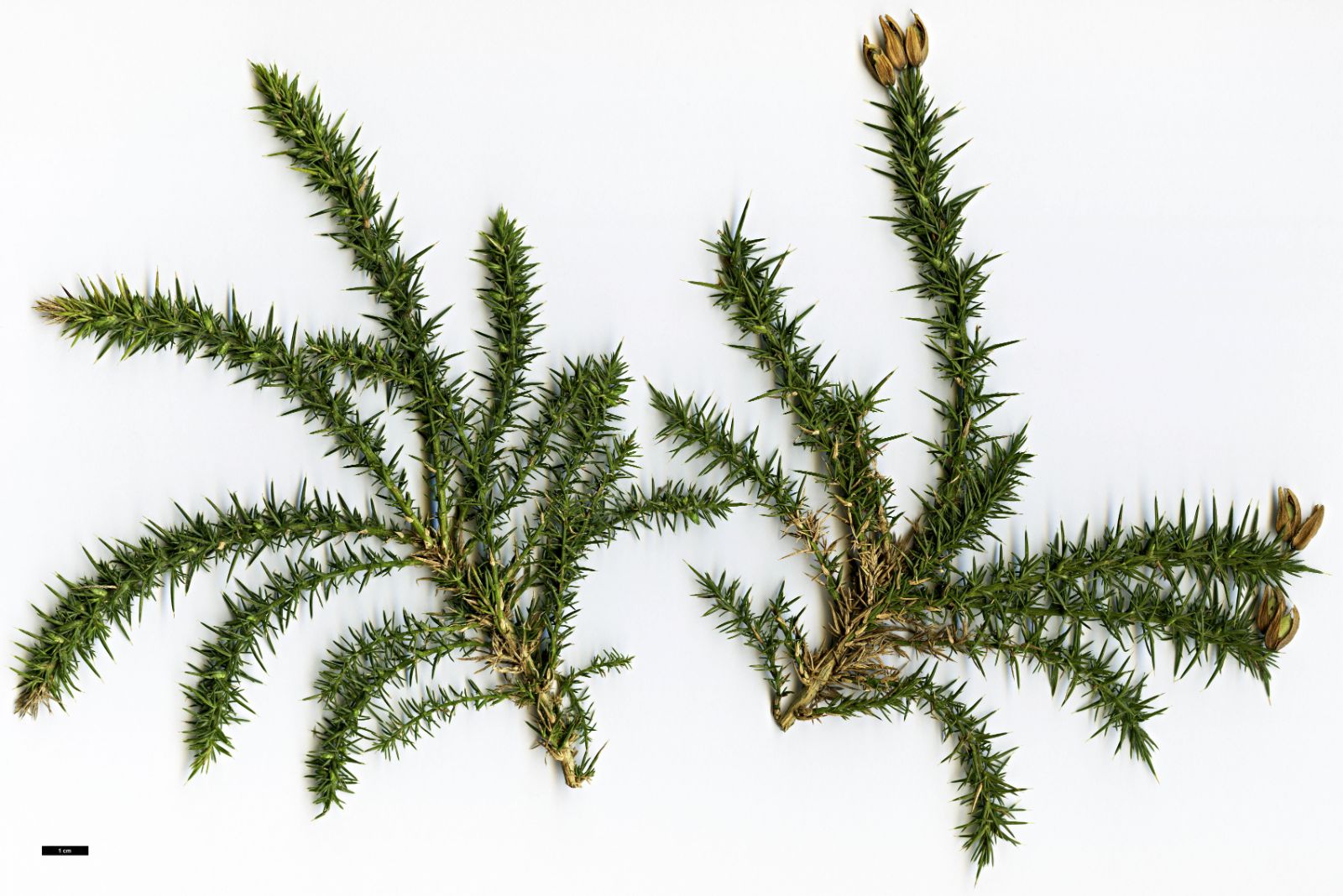Ulex gallii
Sponsor
Kindly sponsored by
a member of the International Dendrology Society
Credits
Julian Sutton (2022)
Recommended citation
Sutton, J. (2022), 'Ulex gallii' from the website Trees and Shrubs Online (treesandshrubsonline.
Genus
Common Names
- Western Gorse
Synonyms
- Ulex minor subsp. gallii (Planch.) Castrov. & Valdés Berm.
- Ulex gallii subsp. breoganii (Castrov. & Valdés Berm.) Rivas Mart. et al.
Infraspecifics
Other taxa in genus
Shrub to 1(–2) m, erect to prostrate. Young branchlets with both long, spreading and short, curved, appressed hairs. Primary spines stout, to 3 cm long, straight or slighty curved, their branches densely clustered towards the base and shorter than the primaries. Primary phyllodes 5–8 mm, triangular-lanceolate or linear-lanceolate, spine-like, spreading, with ciliate margins; secondary phyllodes lanceolate-linear, often almost as long as its spine. Bracteoles 0.5–1 × 0.5–1 mm, ovate to ovate-lanceolate, pubescent; pedicel 3–6 mm. Calyx (8–)9–12(––14.5) mm, lower or both lips tapering towards the base, with short hairs; upper lip 2–4 mm wide. Corolla: banner (9–)11–15.5 × 6–9 mm, usually exceeding the calyx by >2 mm, and longer than wings, glabrous; wings 9.5–14 × 2–4 mm, equalling or slightly exceeding the keel; keel 9.5–13.5 × 3–4.5 mm. Fruit 8–10 × 3.5–4.5 mm, obovate or obovate-oblong, with long, soft hairs, 1–4 seeds per fruit. Seeds 2.3–2.8 × 2–2.5 mm. 2n=64 or 96 (tetraploid or hexaploid). (Álvarez Martínez, Fernández Casado & Fernández Prieto 1988; Cubas 1999).
Distribution France Ireland Spain United Kingdom
Habitat Heathland, grasslands, coastal shrublands, woodland margins, on acidic to neutral soils; 0–1620 m asl.
USDA Hardiness Zone 6-9
RHS Hardiness Rating H6
Conservation status Least concern (LC)
Ulex gallii belongs to that small set of gorses which extend up the Atlantic coast of Europe, well north of the Iberian Peninsula. To anyone living in the west of Britain or Ireland it is the familiar summer rather than spring-flowering gorse of lowland heaths and clifftops, where it sometimes grows almost prostrate. In garden terms, its densely branched, prickly bushes resemble the more widespread U. europaeus, except that its peak flowering falls later in the year, late summer in Britain. As with other gorses, more or less full sun and poor, neutral to acidic soil will give the best looking plants. Just one cultivar, the very low-growing ‘Mizen Head’, is a significant garden plant in Europe.
Western Gorse and Dwarf Gorse (the U. gallii–minor complex) are relatively easily recognized as distinct from Ulex europaeus by their smaller flowers with downy rather than thickly hairy calyces. The complex has traditionally divided into two species which can usually be distinguished on morphology (Kirchner & Bullock 1999). However, there seem to be three entities in this complex based on chromosome number, a diploid, a tetraploid and a hexaploid. Molecular evidence hints that these form a polyploid series (Fonseca et al. 2021). Contemporary workers agree that only the diploids belong in U. minor. The polyploids may be lumped together as U. gallii in a broad sense (Stace 2019; Cubas 1999), as we do here. Structural differences between them are quantitative rather qualitative. The longer spines and (more reliably) longer petals (banner, wings and keel) proved good but not perfect indicators of tetraploid U. gallii in a Dorset population which grew alongside diploid U. minor (Kirchner & Bullock 1999). The authors insisted that morphology alone cannot give a definitive identification. Unlike shallow-rooted U. minor, U. gallii usually has a tap root (Stokes, Bullock & Watkinson 2003). Hybrids between U. minor and U. gallii seem rarely to have been seen or seriously suggested.
Some go further, attempting to distinguish the two polyploids as subspecies of U. gallii or as full species, but this remains contentious. Data on correlations between karyotype and both morphology and distribution are weak and sometimes conflicting; moreover it is impossible to be certain of the karyotype of old herbarium specimens used as types. We outline suggested taxonomic schemes only to help make sense of names current in the literature. One attempt (Álvarez Martínez, Fernández Casado & Fernández Prieto 1988; apparently followed by Royal Botanic Gardens, Kew 2022) treats the tetraploid as U. gallii and the hexaploid (at least in N Spain) as U. cantabricus Álv.Mart., Fern.Casado, Fern.Prieto, Nava & Vera. (Any scheme which restricts hexaploids to Spain is in conflict with Misset & Gourret (1996) who found they were the norm at a site in Brittany, France. A second scheme (as used by the influential Flora Iberica – Cubas 1999) involves distinguishing the hexaploid as U. gallii subsp. gallii and the tetraploid (claimed as having marginally smaller flowers and fruit) as U. gallii subsp. breoganii (Castrov. & Valdés Berm.) Rivas Mart. et al.; contemporary Iberian workers often make this distinction. However, the name U. × breoganii is currently also used for suspected hybrids between U. europaeus and U. gallii (Stace, Preston & Pearman 2015; Royal Botanic Gardens, Kew 2022). Confusion reigns, and this risks research on one taxon being cited as relating to another.
Hybrids between U. gallii and U. europaeus are thought to be quite frequent where they occur together in Britain. The parents sometimes flower together in autumn. Hybrids are fertile and intermediate (Stace, Preston & Pearman 2015). In Brittany, where summer flowering in U. europaeus is common, molecular evidence supports the idea that intermediate plants may be hybrids (Misset & Fontenelle 1992).
This species was described in 1849, later than U. minor and U. europaeus, from material collected in Brittany and Dorset; Planchet’s name commemorates the Breton botanist and judge Nicolas Le Gall. It does not figure in early literature on cultivated gorses. Bean (1981) found it rather less hardy than these other two species at Kew, but considered it pretty if grown on poor soil, especially mixed with the others for continuity of flowering. Apart from the cultivar ‘Mizen Head’, it is rare in European collections, although it grows at Meise Botanic Garden, Belgium (Plantcol 2022). It is apparently unknown in North America.
'Mizen Head'
A prostrate, mat-forming plant flowering in July and August. Collected about 1970 at Mizen Head on the extreme southwestern coast of Ireland, by Peter and Patricia Cox, and introduced through their Glendoick Gardens, Scotland (Nelson 2000). A useful prickly groundcover plant (Edwards & Marshall 2019), it is today one of the most widely planted gorses in European gardens, along with U. europaeus ‘Flore Pleno’. The name is sometimes mis-spelled phonetically as ‘Mizzen Head’, or wrongly shortened to ‘Mizen’ or ‘Mizzen’.




